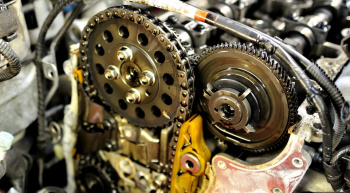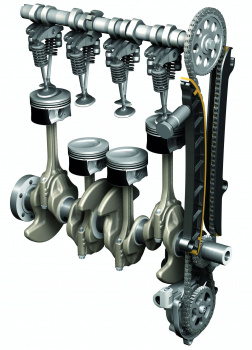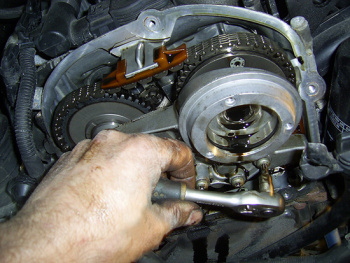
Is your timing chain worn out? Is it the time to replace it? In this article we explain how you can identify a defect in timing chain and what the costs are for replacing it. First, however, we tell something about the operation of the chain, the advantages and disadvantages and which cars are equipped with it.
Replacing a timing chain can entail high costs. It is therefore advisable to request a quote before you have the repair carried out.
What is a timing chain?
A timing chain is one of the most important parts of your car. It is responsible for the connection and synchronization of the crankshaft with the camshaft. Without a properly functioning chain, your engine cannot run and your car cannot drive.

The functioning of a timing chain is basically the same as that of a timing belt. The difference is only that the chain is made of extra hard steel links that engage in gears (just like with a bicycle, for example), while a belt is made of plastic and is provided with ridges that engage in a slightly different type of gears.
Advantages of timing chain
The advantage of a chain is that, in principle, it lasts much longer than a timing belt. A timing belt is preventively replaced every 80,000 kilometers, depending on the model and type. A chain is made to last a car life, so it should never be replaced.
Disadvantages of timing chain
The practice is unfortunately somewhat different from the theory. In many cars where a chain is responsible for distribution, the chain must still be replaced regularly. And such a repair is much more expensive than replacing a timing belt. Replacing a timing belt can cost you 300 – 800 euros, while replacing a chain is often much more expensive. Manufacturers place the timing chain at the bottom or at the back of the block, resulting in much more work for engineers to replace it.
Another disadvantage is the damage that occurs when the chain breaks. When a timing belt breaks, the damage is barely manageable, but when a chain breaks, you can be sure that your car will only pay off at the old iron farmer. A loosened chain will simply shatter the whole block.
Which car has a timing chain?
You can easily find out if your car has a timing belt or chain by referring to the supplied maintenance booklet. Otherwise, ask your maintenance engineer.
There are also some cars and motorcycles that are notorious for their problems with the distribution chain. Below you will find an overview of this.
Timing chain with 1.2 & 1.4 TSI engines
The TSI engines from Volkswagen are beautiful engines, because they deliver a lot of power with low consumption. Unfortunately, especially the frequently used 1.2 and 1.4 engines from a few years ago have enormous problems with the distribution chain.
These problems are usually caused by a malfunctioning chain tensioner. This causes the chain to stretch slowly, causing it to become loose. As a result, the chain tensioner is loaded even more heavily, so that in the long run it can no longer hold and the engine dies with a loud bang. We often come across cars with serious damage to the TSI engine as a result of this problem.
Toyota Aygo timing chain replaced (and Peugeot 107 / Citroën C1)
The cars of the PSA trio Aygo, 107 and C1 (all cars of the same concern) are very popular as a city car. These cars have a chain for distribution that almost never lasts longer than 80,000 km. We also often purchase these cars, because the costs for repairs hardly ever outweigh the repair costs.
Replace Alfa 159 timing chain
Distribution problems also occur regularly with Alfa Romeo’s JTS engines. Just like with the TSI engine, this is often not well under tension, which means it stretches and gives a malfunction. Replacing the chain or selling the car is often the only option.
Opel Corsa problems
The timing chain on the Opel Corsa C is also known for breaking down faster than Opel had planned. In theory, it would have to go at least 200,000 kilometers, but there are cases where the chain jumped after 140,000 km and the engine crashed. That is why, as a rule, the chain on these cars needs to be replaced after about 100,000 km.
Symptoms of broken timing chain
A breaking timing chain can be fatal to your engine, but luckily there are some signs that tell you something is wrong with this part. Never ignore these four symptoms of a worn timing chain:
- You will hear a ticking or rattling sound from under the hood. When the chain wears, the tension goes off. This causes vibrations on the chain while turning. You can often hear this as a ticking or rattling of the engine. This is usually the worst when the engine is still warming up.
- The engine simmers and delivers less power. As we indicated, the chain is responsible for synchronizing the camshaft with the crankshaft, and thus for opening and closing the valves on time and moving the pistons. This system is of vital importance for the engine to function properly. When the chain is worn, the valves will open too early or too late, causing the engine not to function optimally. It then simmers (misfire) and delivers less power, which you notice when accelerating and on the highway.
- There are pieces of metal in the engine oil. If you notice that there are pieces of metal in the oil when changing the oil , chances are that they will come from the timing chain. Because the chain stretches and starts vibrating, pieces of metal will break off, which will end up in the oil. You can clearly see this in the engine oil that comes out of your car.
- The engine failure light is on. When something is wrong with your engine, a light on your dashboard lights up to warn you that there is a problem. Even when the distribution no longer functions optimally. Note that such a lit light can also have a number of other causes.
Can you continue with a worn timing chain?
As we have already mentioned above, it is not wise to continue with a worn distribution chain. To start with, it is unsafe to drive with a malfunctioning engine, because this can lead to dangerous situations, for example during overtaking maneuvers or when inserting onto the highway.
In addition, the chain will eventually break, which has catastrophic consequences for your engine. In many cases, a new engine will have to be installed, which in practice means nine out of ten times that you can take your car to scrap.
Cost of replacing a timing chain

The costs for having a timing chain replaced depend on the model and type of your car. They usually range from around 700 to 1500 euros. Sometimes cheaper, but 3000 euros is also possible, if you have a car where the entire block has to separate to replace the chain. The chain tensioner and camshaft adjuster must also be replaced more than once, which also entails additional costs.
The repair costs also depend on where you have the repair carried out. In general, repairs are more expensive at the brand dealer than at the general garage, because of the higher labor costs that they charge there. In the table below we have listed the average costs for replacing the chain for common models.
Cost of timing chain replacement per model
| Brand and model | Engine type | Cost of replacing distribution chain |
|---|---|---|
| Volkswagen Golf | 1.2 TSI | € 700-1400 |
| Volkswagen Golf | 1.4 TSI | € 800 – 1500 |
| Opel Corsa | 1.2 16V | € 750 – 1250 |
| Alfa Romeo Mita | 1.3 JTD | € 800 – 1300 |
| Suzuki Swift | 1.3 DDiS 16V | € 900 – 1400 |
| Peugeot 207 | 1.4 16V | € 700 – 1200 |
| BMW 3 series | N43 | € 1500 – 3500 |
| Mercedes Benz A-Class | 180 CDI | € 1150 – 2550 |